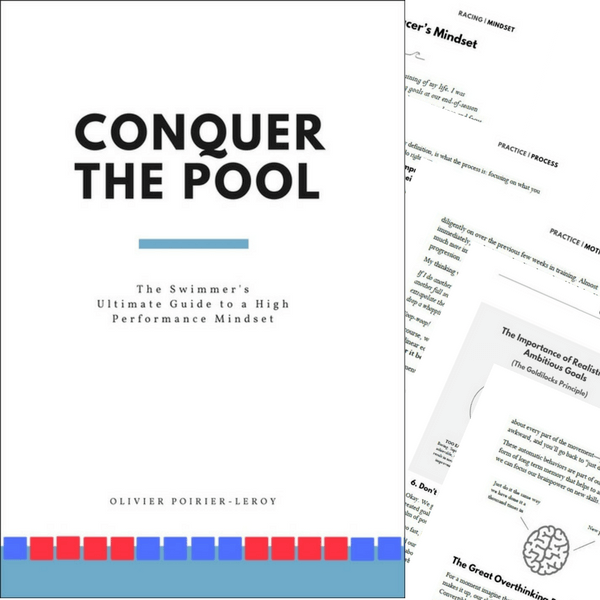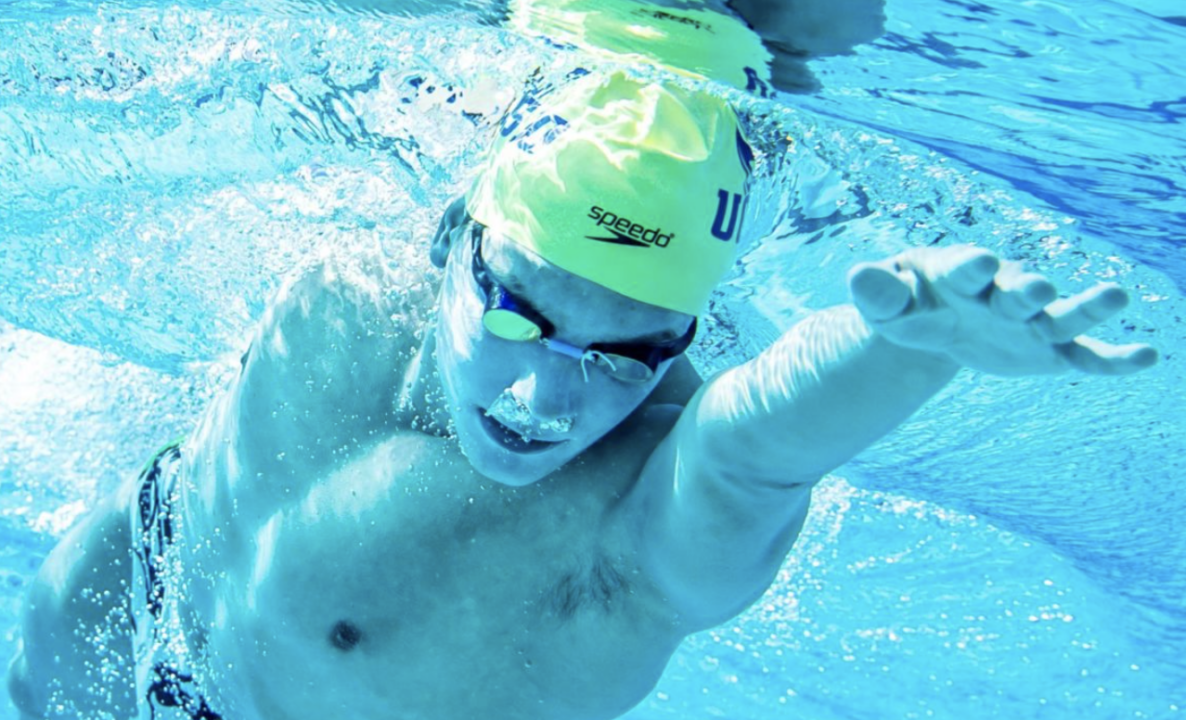Looking to get started with some swim training? Here are some awesome swim workouts for beginners.
Swimming is one of the best forms of exercise around. Spending time in the lap pool boosts mood, reduces stress, improves pulmonary function, burns a ton of calories, is low impact, and much more.
But for beginners, swimming can be a little intimidating.
There’s all that swim terminology (DPS? SWOLF? Early vertical forearm? Henh?) and all of the different strokes, swimming gear, and training methodologies.
Or maybe you are coming back after a long stretch away from the pool, and you don’t know where to start.
In this guide, we will detail some swim workouts for beginners.
Whatever your goals in the pool or current fitness levels, these swim workouts are perfect for those just getting started with the sport.
Swimming Workouts for Beginners
In this breakdown of my favorite swimming workouts for beginners, we will cover all of the bases of getting better in the pool.
The five swim workouts include:
- Intervals (HIIT)
- Full-body (IM, strokes, etc.)
- Introduction to Swim Gear (Kick and Pull)
- Stroke Counting and Efficiency
- Going the Distance (Increasing endurance)
Each swim workout has three parts:
- A warm-up to promote blood flow, loosen up the joints and muscles, and increase feel for the water.
- The main set, where the magic happens.
- And a warm-down where we come down from the hard work and maintain a commitment to swimming smooth and efficiently.
Structuring your swim workouts this way helps to keep you focused and avoids “junk yards” that are commonplace when swimmers head to the pool without a plan or goal.
And as you get more comfortable with swimming, you can use this template to create some swim workouts of your own.
Alrighty, let’s dive in and get to the good stuff:
Beginner Swim Workout #1: Interval Training (HIIT)
Looking for an action-packed, calorie-busting swim workout? High-intensity interval training is where it’s at!
Interval training is a form of exercise that alternates near, maximal, or supra-maximal effort with rest. Swim fast for a bit, take some rest, and repeat.
While there are several types of interval training swim workouts, high-intensity interval training (HIIT) is the most popular and easy to implement for beginners in the pool.
Studies have shown HIIT to be effective for improving VO2 max, resting metabolic rate (i.e. burning more fat over the course of the day), and aerobic conditioning (Akataken et al., 2021).
Compared to steady-state workouts, HIIT has also been shown to be more enjoyable (Thum et al., 2017). No surprise there!
Here is a sample swim workout for beginners that focuses on HIIT:
- Warm-Up: 200 swim – Mix the different strokes + 4×25 swim build to 90% effort with 30 seconds rest after each 25
- Main set: 16×25 swim fast (90% effort), take 30 seconds rest after each 25
- Warm-Down: 100 swim mix
- Total Distance: 800m
The best thing about HIIT swim workouts is that you don’t have to overthink it. Jump in, warm up properly, and get after it!
The simplicity is also why it’s among my favorite 30-minute swimming workouts on days when I am short on time.
Beginner Swim Workout #2: Full-Body Training
One of the best aspects of swimming as a sport and as a form of exercise is how versatile it is. Unlike running or cycling, where you have some slight variations of a singular type of exercise technique, with swimming you’ve got a ton of options for strokes.
In this swim workout designed for beginners, we are going to take a full-body approach to swimming, mixing up the different strokes.
Mixing up strokes regularly is also a great way to combat boredom and reduce injury from rote repetition.
- Warm-Up: 200 swim – alternate freestyle and backstroke (or breaststroke) each 25
- Main set: 10×50 swim at 80% effort – 25 freestyle and 25 swim stroke that is not freestyle – 25 seconds rest
- Warm Down: 100 swim easy
- Total distance: 800m
Beginner Swim Workout #3: Introduction to Swim Gear
Swimming allows you the opportunity to focus on the upper or lower body through the use of a kickboard or pull buoy.
These two swim aids are the old-school classics for isolating the upper and lower body and form the foundation of more advanced swim gear to come later in your swim journey, including swim paddles, fins, swim parachutes, and more.
This swimming workout for new swimmers can be changed to be leg-focused or upper-body-focused.
- Warm-Up: 200m alternating 50m swim and 50m kick (or pull)
- Main set: 2x [4x50m swim with 20 seconds rest + 4×25 kick (or pull) fast with 20 seconds rest between reps]
- Warm-Down: 8×25 swim with perfect technique with 30 seconds rest between reps
- Total distance: 900m
Beginner Swim Workout #4: Introduction to Stroke Counting
One of the secrets of elite swimmers is efficiency. Watch Olympic-level swimmers like Michael Phelps, Caeleb Dressel, or Katie Ledecky, and you see controlled effort.
No wasted strokes, no thrashing. This type of effortless-looking efficiency is honed over years of swimming up and down the pool, mastering each part of the stroke and seeking ways to pull and kick more water while also creating less resistance.
A way to introduce beginner swimmers to the concept of efficiency in the pool is by counting strokes.
The main set of this swim workout is all about swimming with awesome technique and using as few strokes as possible to cross the pool (without completely sacrificing speed, obviously).
As the weeks and months go on, aim to decrease the number of strokes you take to complete a length in the pool.
Most swim watches are excellent for counting strokes and combining elapsed time to give you a “SWOLF” score. SWOLF in swimming is an excellent metric to use to track improvement in the water.
By combining the number of strokes you take with the time elapsed, you get a strong indicator of overall efficiency in the water.
- Warm-up: 300m as 100m swim, 100m kick, 100m pull
- Main Set: 16×50 freestyle swim – Focus on distance per stroke and count your strokes and determine an average stroke count – Take 25 seconds rest after each 50
- Warm-Down: 100m swim easy
- Total distance: 1,200m
Tip: Body position plays a huge role in efficient swimming. Focus on keeping your hips high and preventing the legs from dragging behind you. A cue that you can use for high hips is to imagine yourself swimming downhill as you cross the pool.
Beginner Swim Workout #5: Building Speed Endurance
Now that we’ve gotten our feet wet (ha, swim pun!), it’s time to crank up the distance and intensity a little bit.
This swim workout for beginners will introduce you to the concept of pacing and descending effort. As the main set of the swim workout progresses, you will be tasked with increasing speed as the distance decreases.
This type of swim set is also mentally engaging–you’ll have to focus on hitting the proper pace and rest protocols. It’s a great way to introduce yourself to the pace clock or using a swim watch to track times.
Warm-Up: 300m swim – build last 25m to about 75% effort
Main Set:
- 5×100 freestyle – best average pace – take 30 seconds rest after each 100
- 10×50 freestyle – Beat the average pace from the 100s (i.e. if you averaged 1:20’s on the 100s, swim under 40 seconds per 50) – take 25 seconds rest after each 50
- 10×25 freestyle – Beat the average pace from the 50s (i.e. if you averaged 38 seconds on the 100s, swim under 19 seconds per 25) – take 20 seconds rest after each 25
Warm-Down: 6×25 freestyle smooth with perfect technique – 30 seconds rest after each 25
Total Distance: 1,700m
What equipment do beginners need for swim workouts?
Beginner swimmers don’t require a lot of equipment, but there are a few types of swim training equipment that can make swim training more effective and enjoyable.
A swimsuit that fits well, doesn’t weigh swimmers down, and provides a full range of movement is obviously essential. The best swim goggles help you see underwater and protect the eyes from chlorine. Goggles also help you see your pace, whether on a swim watch or using the pace clock.
Other swim training aids include a kickboard and pull buoy, for isolating the lower and upper body, respectively. Swim fins are a great tool for strengthening the legs and improving body position.
How long should I warm up before a swim practice?
Swimming is relatively low-impact but not immune to injuries. Experienced swimmers know this acutely. Swimmer’s shoulder, an injury so pervasive that it’s named after the sport, is very common.
A study of NCAA Division I swimmers titled “Injury Patterns in Division I collegiate swimming,” published in the American Journal of Sports Medicine, found that the shoulder was the most reported injured body part.
Another study, titled “A survey of interfering shoulder pain in United States competitive swimmers,” with American club swimmers, found that 26% of the national team was experiencing shoulder pain when they were surveyed.
Implement dynamic stretches (arm swings, leg swings, and core activation) before your swimming workouts to loosen up the joints, promote blood flow to target muscles, and prime yourself for a great swim workout (see also: 8 Essential Stretches for Swimmers).
Core exercises for swimmers are another excellent addition to your pre-workout routine, as an engaged core helps you swim with better technique, reduces the risk of injury, and even helps you exert more power in the water.
How often should beginners do swim workouts?
Swimming, like any exercise, should be approached with a progression mindset. Start slow and easy, building up the meters and yards over the weeks and months ahead.
Beginners should aim for 3 sessions in the pool to get started and build up the meters-per-session and sessions-per-week from there.
As you saw with the HIIT swim workout above, more isn’t necessarily better. You can still bang out a killer workout without devoting endless hours to the pool.
And as always, consult with a medical professional or physician before embarking on any new fitness regimen.
ABOUT OLIVIER POIRIER-LEROY
Olivier Poirier-Leroy is a former national-level swimmer. He’s the publisher of YourSwimBook, a ten-month logbook for competitive swimmers.
 He’s also the author of the recently published mental training workbook for competitive swimmers, Conquer the Pool: The Swimmer’s Ultimate Guide to a High-Performance Mindset.
He’s also the author of the recently published mental training workbook for competitive swimmers, Conquer the Pool: The Swimmer’s Ultimate Guide to a High-Performance Mindset.
It combines sport psychology research, worksheets, anecdotes, and examples of Olympians past and present to give swimmers everything they need to conquer the mental side of the sport.
Ready to take your mindset to the next level?
Click here to learn more about Conquer the Pool.
